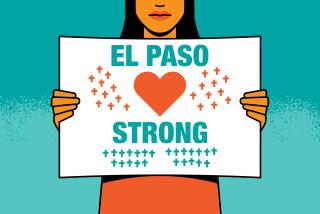Shared Legacy of Pain Brings Cities Together
- Share via
There was no public memorial service in Cerritos on Thursday, no speeches, nothing to publicly commemorate the 82 people who died when an Aeromexico passenger jet crashed into a residential neighborhood 20 years ago.
Residents seem to want it that way.
“It was a very painful memory in the life of Cerritos,” said Don Knabe, who was mayor then and now is a Los Angeles County supervisor.
But in a quiet yet purposeful way, the upscale suburb 20 miles southeast of downtown Los Angeles has found a way to mark the air disaster.
It involves the tight bond formed between Cerritos and the small town of Loreto, Mexico, which was home to 20 of the plane’s passengers.
Over the years, Cerritos residents have donated time and money to help the town. They provided Loreto with its first ambulance and firetrucks and supplied schools with desks, copy machines and computer equipment. They also are helping fund the construction of a firehouse.
“We were brought together by tragedy,” said Jim Weisenberger, founder of the Friends of Loreto Foundation.
“We don’t memorialize the crash. We memorialize life and the future and the relationship between the two cities.”
The Aeromexico DC-9 had left Loreto early in the morning of Aug. 31, 1986, carrying 64 passengers. As it passed about 6,000 feet above Cerritos en route to Los Angeles International Airport, the jet was clipped by a single-engine plane flown by William Kramer of Rancho Palos Verdes.
Kramer and his wife and daughter were killed instantly. The damaged jet lost control and dived into the quiet neighborhood just before noon.
In addition to the 67 people killed on the two planes, 15 Cerritos residents died amid the flaming wreckage and burning jet fuel that destroyed at least eight homes.
The unexpected trauma was something that Cerritos residents had a hard time forgetting.
Paul Bowlen, the current mayor, was on his way home from church when he saw the billowing smoke. After seeing the crash site, Bowlen said, he was unable to get on a plane for at least five years.
“And even then it was a white-knuckler,” he said.
Residents actively resisted attempts to publicly commemorate the disaster. A 1996 plan to build a memorial at the crash site was shelved after two dozen residents signed a petition opposing it.
Instead, the City Council decided to hold a moment of silence during a council meeting.
The city finally did build a memorial earlier this year. The sculpture, bearing the names of all of the victims, was dedicated in March next to City Hall.
The only reason longtime residents felt comfortable with the memorial, Knabe said, “is because it was away from the crash site.”
The Friends of Loreto Foundation was formed in the early 1990s when Weisenberger and a few other Cerritos residents visited the quiet Baja California town of about 10,000 residents. The town has an international airport that fuels the local tourism industry.
The hospital in Loreto, he recalled, “looked like something out of World War I.”
There was no defibrillator, and the nearest X-ray machine was 40 miles away. The town now has its own machines, which provided by the Friends of Loreto Foundation.
“It just kind of grew into something special,” Weisenberger said.
“They felt the same pain that we did.”
This spring, a delegation from Loreto came to Cerritos to attend the dedication ceremony for the long-delayed memorial to the crash victims.
Mayor Bowlen recalled that his Loreto counterpart, Davis Osuna, delivered an emotional speech that explained his personal connection to the tragedy.
Osuna was a member of the Aeromexico ground crew in the Loreto airport, and was one of the last people to speak with the pilot before takeoff.
During the ceremony, Bowlen watched as Cerritos and Loreto residents looked at the names of their dead relatives on the memorial’s stone.
He said he was reminded of his visit to the Vietnam War memorial in Washington.
“They would read the names and get that faraway stare, like they were remembering,” he said.
More to Read
Sign up for Essential California
The most important California stories and recommendations in your inbox every morning.
You may occasionally receive promotional content from the Los Angeles Times.













